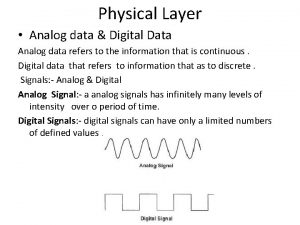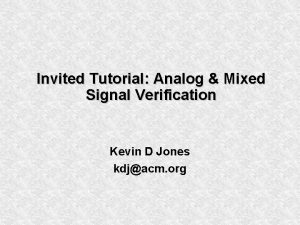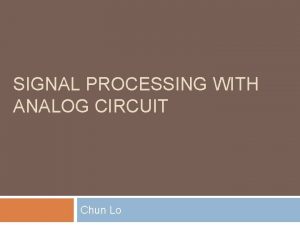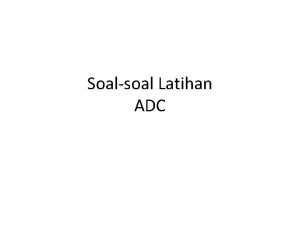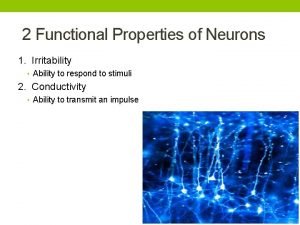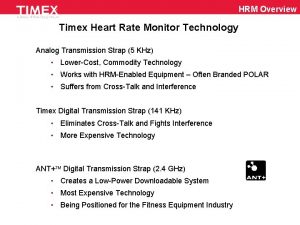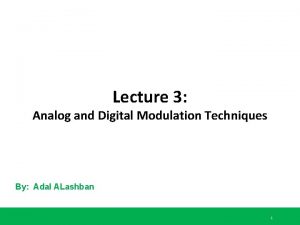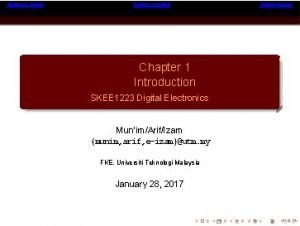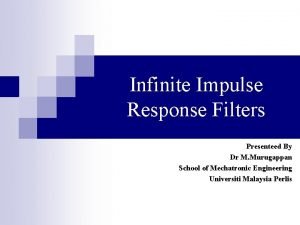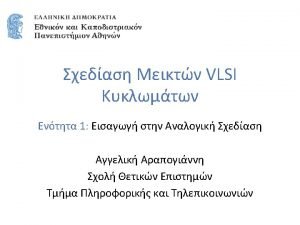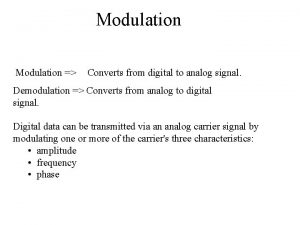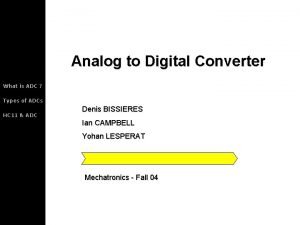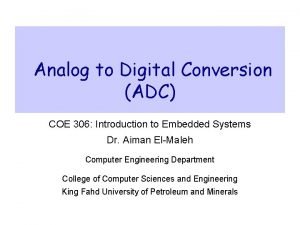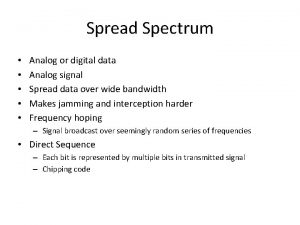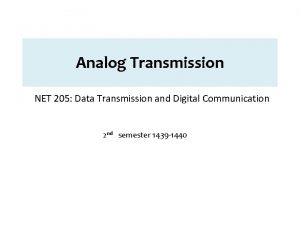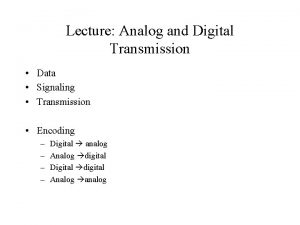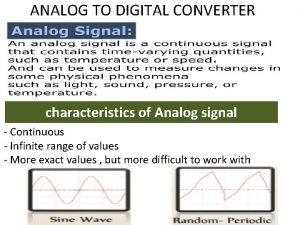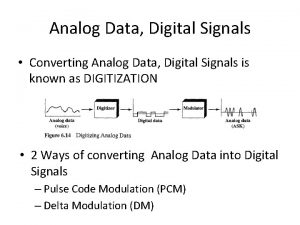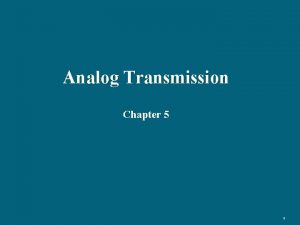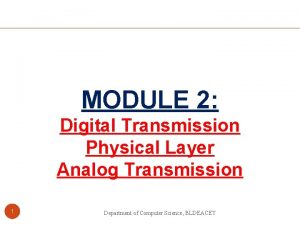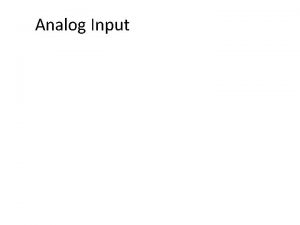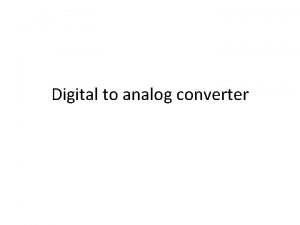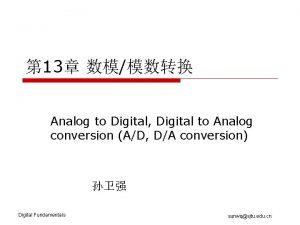Analog Data Digital Signal Data Transmission And Digital


































- Slides: 34

(Analog Data, Digital Signal ) Data Transmission And Digital Communication Lecture 5– 2019/1440 By: Elham Sunbu

OUTLINE • Sampling. PAM • Pulse Amplitude Modulation. • Analogue to Digital conversion. • Sampling (PCM). • Pulse Code Modulation Advantages. • Pulse Code Demodulation. PCM

Pulse Amplitude Modulation(PAM) 3

Introduction - An analog signal: amplitude can take any value over a continuous range. - Digital signals: amplitude can take only discrete and finite values. - Note: can we convert an analog signal to a digital signal. 4

Introduction - One can convert an analog signal to a digital signal by sampling and quantizing (collectively called analogto-digital conversion, or ADC). - The processed signals are then converted back into analog signals using a reconstruction or interpolation operation (called digital-to-analog conversion, or DAC). 5

Sampling Process - The sampling process is a basic operation in the digital communication. - In this process, the continuous-time analog signal is sampled by measuring its amplitude at a discrete instants. - So, the continuous-time analog signal is converted into a corresponding sequence of samples that are usually spaced uniformly in time. - It is necessary to choose the sampling rate properly, so the sequence of samples uniquely defines the original analog signal. 6

7

Sampling - To sample a continuous-time signal x(t) is to represent x(t) at a discrete number of points, t = n. Ts , where Ts is the sampling period. 8

Sampling - The sampling theorem states that a band-limited signal x(t) with a bandwidth W ( W is the highest frequency) can be reconstructed from its sample values if the sampling rate (frequency) fs =1/Ts is greater than or equal to twice the bandwidth W of x(t) - The minimum sampling rate of fs for an analog bandlimited signal is called the Nyquist rate. 9

Sampling - There are 3 sampling methods: • Ideal - an impulse at each sampling instant. • Natural - a pulse of short width with varying amplitude. • Flattop - sample and hold, like natural but with single amplitude value. 10

Sampling - As long as the sampling of the analog signal is taken with a sufficiently high frequency (higher than the minimum Nyquist rate of twice the signal largest frequency), it can be shown that there is no loss in information as a result of taking discrete samples. 11

PAM Pulse Amplitude Modulation 12

13

Introduction - CW modulation: a parameter of a sinusoidal carrier wave is varied continuously in accordance with the message signal. Amplitude, frequency and phase. - Pulse Modulation: signal is transmitted at discrete intervals of time. - Pulse modulation can be analog pulse modulation or digital pulse modulation. 14

15

Pulse Amplitude Modulation (PAM) - In the PAM, the amplitude of periodic pulse train is varied with a amplitude of the corresponding sample value of a continuous message signal. - In PAM: width and position are fixed but amplitude varies. 16

Pulse Amplitude Modulation (PAM) 17

Pulse Amplitude Modulation (PAM) - Natural PAM top portion of the pulses are subjected to follow the modulating wave. 18

Pulse Amplitude Modulation (PAM) - Pulse width modulation is also called pulse duration modulation (PDM). - Pulse width modulation: position and amplitude are fixed but width varies. - PWM is more often used for control than for communication. LEDs: output luminosity is proportional to average current. 19

Pulse Amplitude Modulation (PAM) - Pulse position modulation: width and amplitude are fixed but position varies. - The value of the signal determines the delay of the pulse from the clock. 20

Time Division Multiplexing (TDM) - In many cases, bandwidth of communication link is much greater than signal bandwidth. - All three methods can be used with time-division multiplexing (TDM) to carry multiple signals over a single channel. 21

Analog to Digital Conversion - A digital signal is superior to an analog signal. - Digital is less prone to noise and distortion. - We can’t use analog signals for long distance (lose their strength, which means amplifiers are needed to amplify signal. However the amplifier creates distortion in the signal and adds some noise). - The tendency today is to change an analog signal (such as audio , voice and music) to digital data. - Pulse Code Modulation (PCM) is a technique to convert analog data to digital signal. 22

Pulse Code Modulation(PCM) 23

Analog to Digital Conversion • The idea of digitizing analog signal started with telephone companies, to provide long distance services; They digitized the analog signal at the sender; The signal is converted back to analog at the receiver. - Pulse Code Modulation (PCM): 1 - Sampling (PAM). 2 - Quantization. 3 - Binary encoding. 4 - Line or block coding. 24

1. Sampling (PAM) • The first step in PCM is sampling. • The analog signal is sampled at equal interval, every Ts s (sample interval) • The inverse of sampling interval is sampling rate or sampling frequency. fs= 1/Ts • Sampling rate: number of samples per second.

1. Sampling PAM (Pulse Amplitude Modulation)

2. Quantized PAM Signal • The result of PAM is a series of pulses with amplitude values between the maximum and minimum amplitudes of the signal with real values. • Quantization: is a method of assigning integer values in a specific range to sampled instances. 27

3. Binary Encoding - Each quantized samples is translated into equivalent binary codes. 28

4. Line Encoding - The binary digits are then transformed to a digital signal using one of the line encoding. 29

Components of PCM Encoder

PCM Block The basic elements of a PCM system

Pulse Code Modulation Advantages 1. Analog signal can be transmitted over a high speed digital communication system. 2. Probability of occurring error will reduce by the use of appropriate coding methods. 3. PCM is used in Telkom system, digital audio recording, digitized video special effects, digital video, voice mail. 4. PCM is also used in Radio control units as transmitter and also receiver for remote controlled cars, boats, planes. 5. The PCM signal is more resistant to interference than normal signal.

Pulse Code Demodulation • Pulse Code Demodulation: will be doing the same modulation process in reverse. • Demodulation starts with decoding process • During transmission the PCM signal will effected by the noise interference.

Thank You 34
 Digital signal as a composite analog signal
Digital signal as a composite analog signal Digital vs analog transmission
Digital vs analog transmission Difference between analog and digital editing
Difference between analog and digital editing Analog data and digital data
Analog data and digital data Digital data to digital signal encoding
Digital data to digital signal encoding Analog mixed signal verification
Analog mixed signal verification Digital transmission advantages
Digital transmission advantages Precision analog signal processing
Precision analog signal processing Rumus adc
Rumus adc Digital to analog conversion in data communication
Digital to analog conversion in data communication Compare and contrast analog and digital forecasts.
Compare and contrast analog and digital forecasts. Compare and contrast analog and digital forecasting
Compare and contrast analog and digital forecasting Nerve signal transmission steps
Nerve signal transmission steps Baseband signal and bandpass signal
Baseband signal and bandpass signal Baseband signal and bandpass signal
Baseband signal and bandpass signal Classification of signal
Classification of signal Digital data digital signals
Digital data digital signals Timex heart rate monitor chest strap
Timex heart rate monitor chest strap Disadvantages of fsk
Disadvantages of fsk Introduction to digital video
Introduction to digital video Analog image and digital image
Analog image and digital image Analogue and digital transmission in computer networks
Analogue and digital transmission in computer networks Analog vs digital chips
Analog vs digital chips Digital and analog quantities
Digital and analog quantities Introduction to digital control system
Introduction to digital control system Analog vs digital video
Analog vs digital video Compare analog and digital filters
Compare analog and digital filters Introduction to digital control system
Introduction to digital control system Analog and digital difference
Analog and digital difference Perbedaan teknologi digital dan analog
Perbedaan teknologi digital dan analog Analog v digital
Analog v digital Modulation digital to analog
Modulation digital to analog Amw hübsch
Amw hübsch Analog to digital converter types
Analog to digital converter types Single slope adc
Single slope adc



